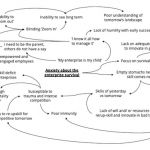If I See One More Post About the Lack of Progress on Impact Metrics, I’m Gonna Lose It
I just read another screed about the failure of metrics to solve the complex problem of business and investment destroying the planet. “ESG data is like less wife beating,” the author complains. I applaud the provocative nature of that phrasing, actually, because it’s great for getting people to pay attention to the subject – at the end of the day, crass wording grabs eyeballs. What’s not great is the incorrect blanket assertion that there’s been no meaningful, systems-level ESG progress in the past decade – as though these systems and the people who design them are living in a fantasy castle in the sky, untouched by the accelerating rate with which business is killing of large percentages of all living species, doing nothing meaningful about it.
The article in question was sent to me by a longtime friend in the social entrepreneurship field who created what has been for a decade one of the biggest platforms for impact investors and entrepreneurs. “Is this what metrics are?” he asked me. I’ve observed that “metrics” are an issue he has preferred to avoid, and one that, to my knowledge, has never been on the main stage at his events. I’m simultaneously glad he’s getting curious about the topic, yet find it impressive he can ask such a question almost 20 years after we first met in our mutual quest to fund investments in people and planet. Could he still be unclear on the differences between metrics, ESG and impact, or on its relevance to investment for impact? I’m usually the first to provide encouragement to folks around these topics, but candidly, given his longevity in the wider field, I find it noteworthy that he isn’t embarrassed to ask.
FRAMEWORK FOR CHANGE
The article, like so many others, asserts that “ESG data is not picking up on this information [whether or not a business is creating a net positive impact] yet.” But it is.
This year, the Dow Jones Sustainability Index asks about the material environmental and social issues facing the business, what kind of scenario planning it is doing around those risks, and what strategies are in place to address them – an evolution of criteria that speaks directly to concerns raised by the author of the article above. This evolution may be driven by the same underlying factors that led the world’s largest asset manager, Blackrock, to criticize systematic mispricing of climate-related risks by investors, or 30 Central Banks to coordinate a standardized way for corporations to publicly disclose their carbon footprints, supporting investors’ ability to understand how their investments drive climate change. And these examples are just the tip of the iceberg.
I understand these advances may feel disjointed – but that too is improving. There is an effort, now in its fourth year, to “provide coherent and end-to-end ‘rules of the road’ for impact management,” which the G7 has just endorsed. This “Impact Management Project” has facilitated over 2,000 global practitioners, standards bodies and investors to a consensus on the shared fundamentals of impact, and currently these fundamentals are percolating into principles, disclosure standards, practical seals and certifications, audit criteria, training materials and more, undergirded by a common conceptual framework. These deliverables are being produced through unprecedented collaboration between a dozen major global impact investing bodies, practitioner networks, development finance standards organizations and ESG standards bodies – including this one, upon which much of ESG reporting is based. The shared fundamentals of impact are centered on stakeholders’ experiences, particularly those of the most vulnerable, and they go as far as to ask how important the change they’re experiencing is, while introducing a form of grassroots valuation into the equation as a counterpoint to the all-powerful financial valuation. All of these efforts can be lumped into the ESG bucket, and all are feeding the investor’s capacity to thoughtfully ask about companies’ actual impacts, risk management practices and abilities to foresee change and design business models that make things better.
Which is why I find it more than curious that so many people continue to claim the following: “Sadly, for those asset owners looking to allocate capital with the intention of generating positive impact, a broadly accepted framework does not yet exist.” I call B.S.
THE FUTURE IS NOW
The marketplace for impact, and the global economy as a whole, can no longer afford to pretend there is no agreement on the right set of information. There IS agreement.
There is consensus that the following three types of information are needed by managers and investors: (1) the overall, important effects of the company on the world (using one of these trusted checklists), combined with (2) the company’s unique, material social and environmental value (as judged using nuanced criteria), and (3) how the company’s financial performance is integrally related to its social and environmental value creation (using this framework).
So readers, beware: Those who still, decade after decade, bemoan the lack of progress probably have something to sell you. Or perhaps they have something they want to keep free from accountability. Or maybe they’re just having a hard time recognizing the change that is happening, because the results haven’t manifested in a big way yet. But progress is being made.
Whose interests are truly served by continuing to act as though we aren’t making progress towards measuring and managing impact in sound ways?
Though keeping tabs on the somewhat-technical evolution of infrastructure meant to hold assets accountable for their effects on the planet is not everyone’s cup of tea, the time when impact professionals could complain about a “lack of progress in the field” while promoting their groundbreaking impact measurement solution is over.
The name of the game now is moving from “What to measure?” to “How do we use this information to drive results?” Those charged with utilizing ESG information today need to have more “multilingual” skills than in the past regarding what they should be looking for, and how to get it from the information provided. While a lot of companies still aren’t disclosing, many are, and the problem is no longer that it’s the wrong information. The problem is that the reader of the information must know what to look for to get something useful out of it.
Skilled impact analysts are needed to bring value to the information that companies and investors are producing. It isn’t an ESG reporting problem: It’s a human capital problem. We need skilled impact analysts to drive the next phase of the impact economy.
FROM FOOT-DRAGGING TO FORWARD MOTION
The next time you hear someone complaining about the lack of progress on metrics or how bad existing metrics approaches are, and/or claiming they have a brand-new solution (step right here to purchase!), please check closely to see if the solution they propose:
- discloses and improves its material ESG issues in accordance with any existing consensus-based standard;
- reports in alignment with the IMP-shared fundamentals of impact, and shows how it is learning from this information;
- discloses the ways the entity’s financial performance depends upon these factors, and how this dependency informs its strategy; and
- provides information that meets your standards for not only quality of disclosure, but for performance results, regenerative or otherwise.
And if the proposed solution does not do those things, check what the stated rationale for this is. If there isn’t one, it’s best to move on.
The bottom line is, we do have the tools to understand the impact of the global capital marketplace, in all its diverse and terrible glory. Let’s own the wonderful fact that we’ve accomplished this together! Sure, there’s room to keep making it better – and we must – but by George, let’s stop muddying the water, letting confused people off the hook while they wait for that mythic day when all questions are perfectly settled before they must account for their impacts on people and the planet.
Instead, recognizing what we do have, let’s teach the proper use of this information, enabling decisions that drive the kind of results the world needs now.
Sara Olsen is Founding Partner and CEO at SVT Group.
This post was originally published on the author’s LinkedIn page. It is republished with permission.
Photo courtesy of Marc Szeglat.
- Categories
- Impact Assessment, Investing



